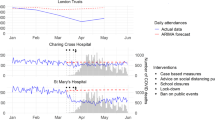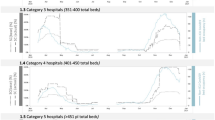Abstract
The fifth wave of COVID-19 outbreaks in Hong Kong (HK) from January to March 2022 has the highest confirmed cases and deaths compared with previous waves. Severe hospital boarding (to inpatient wards) was noted in various Emergency Departments (EDs). Our objective is to identify factors associated with hospital boarding during Omicron surge in HK. We conducted a retrospective cohort study including all ED visits and inpatient (IP) ward admissions from January 1st to March 31st, 2022. Vector Autoregression model evaluated the effects of a single variable on the targeted hospital boarding variables. Admissions from elderly homes with 6 lag days held the highest positive value of statistical significance (t-stat = 2.827, P < .05) caused prolonged admission waiting time, while medical patients with 4 lag days had the highest statistical significance (t-stat = 2.530, P < .05) caused an increased number of boarding patients. Within one week after impulses, medical occupancy’s influence on the waiting time varied from 0.289 on the 1st day to -0.315 on the 7th day. While occupancy of medical wards always positively affected blocked number of patients, and its response was maximized at 0.309 on the 2nd day. Number of confirmed COVID-19 cases was not the sole significant contributor, while occupancy of medical wards was still a critical factor associated with patient boarding. Increasing ward capacity and controlling occupancy were suggested during the outbreak. Moreover, streamlining elderly patients in ED could be an approach to relieve pressure on the healthcare system.




Similar content being viewed by others
Data Availability
We performed a territory-wide, time-series study using data from an electronic administrative health care repository—the Clinical Data Analysis and Reporting System (CDARS), which is an electronic database that connects to electronic health records since 1995 from all public hospitals and clinics managed by Hospital Authority in Hong Kong. It protects patients’ personal data through anonymized hospital ward, clinic and emergency department admissions records, which covers different areas in patient care, namely, diagnosis, patient activities, laboratory and microbiology tests and prescription and dispensing. The patients and their episodes of service utilization were uniquely labelled respectively.
References
Chen L-L, Abdullah SMU, Chan W-M, et al (2022) Contribution of low population immunity to the severe Omicron BA. 2 outbreak in Hong Kong. Nature communications 13:1–10
Chan W-M, Ip JD, Chu AW-H, et al (2021) Phylogenomic analysis of COVID-19 summer and winter outbreaks in Hong Kong: an observational study. The Lancet Regional Health-Western Pacific 10:100130
Al-Tawfiq JA, Hoang V-T, Le Bui N, et al (2022) The emergence of the omicron (B. 1.1. 529) SARS-CoV-2 variant: what is the impact on the continued pandemic? Springer
Chen J, Wang R, Gilby NB, Wei G-W (2022) Omicron variant (B. 1.1. 529): infectivity, vaccine breakthrough, and antibody resistance. Journal of chemical information and modeling 62:412–422
Gu H, Krishnan P, Ng DY, et al (2022) Probable transmission of SARS-CoV-2 omicron variant in quarantine hotel, Hong Kong, China, November 2021. Emerging infectious diseases 28:460
Mesfin Y, Chen D, Bond H, et al (2022) Epidemiology of infections with SARS-CoV-2 Omicron BA. 2 variant in Hong Kong, January-March 2022. medRxiv
Cheung P-HH, Chan C-P, Jin D-Y (2022) Lessons learned from the fifth wave of COVID-19 in Hong Kong in early 2022. Emerging Microbes & Infections 11:1072–1078
Magramo K LT (20220208) Hong Kong Public Hospitals “overwhelmed” by asymptomatic covid-19 patients. In: South China Morning Post. https://www.scmp.com/news/hong-kong/health-environment/article/3166250/hong-kong-hospitals-overwhelmed-asymptomatic
Su Z, Cheshmehzangi A, McDonnell D, et al (2022) The advantages of the zero-COVID-19 strategy. International Journal of Environmental Research and Public Health 19:8767
Boulain T, Malet A, Maitre O (2020) Association between long boarding time in the emergency department and hospital mortality: a single-center propensity score-based analysis. Internal and emergency medicine 15:479–489
Ritchie H, Mathieu E, Rodés-Guirao L, et al (2020) Coronavirus pandemic (COVID-19). Our world in data
Comelli I, Scioscioli F, Cervellin G (2020) Impact of the COVID-19 epidemic on census, organization and activity of a large urban Emergency Department. Acta Bio Medica: Atenei Parmensis 91:45
Uppal A, Silvestri DM, Siegler M, et al (2020) Critical Care And Emergency Department Response At The Epicenter Of The COVID-19 Pandemic: New York City’s public health system response to COVID-19 included increasing the number of intensive care units, transferring patients between hospitals, and supplementing critical care staff. Health Affairs 39:1443–1449
Hartnett KP, Kite-Powell A, DeVies J, et al (2020) Impact of the COVID-19 pandemic on emergency department visits—United States, January 1, 2019–May 30, 2020. Morbidity and Mortality Weekly Report 69:699
Santi L, Golinelli D, Tampieri A, et al (2021) Non-COVID-19 patients in times of pandemic: Emergency department visits, hospitalizations and cause-specific mortality in Northern Italy. Plos one 16:e0248995
Rennert-May E, Leal J, Thanh NX, et al (2021) The impact of COVID-19 on hospital admissions and emergency department visits: A population-based study. PLoS One 16:e0252441
Barten DG, Latten GH, Van Osch FH (2022) Reduced emergency department utilization during the early phase of the COVID-19 pandemic: viral fear or lockdown effect? Disaster medicine and public health preparedness 16:36–39
Wai AK, Wong CK, Wong JY, et al (2022) Changes in emergency department visits, diagnostic groups, and 28-Day mortality associated with the COVID-19 pandemic: a Territory-Wide, retrospective, cohort study. Annals of Emergency Medicine 79:148–157
Hong Kong SAR G (20220215) Latest arrangement on DH’s clinics and service units in view of HA’s designated clinics
Leung H (20220214) ‘It’s a mess’: Covid-19 cases at dozens of Hong Kong care homes as elderly quarantine facilities overwhelmed. In: Hong Kong free press. https://hongkongfp.com/2022/02/14/its-a-mess-covid-19-cases-at-at-dozens-of-hong-kong-care-homes-as-elderly-quarantine-facilities-overwhelmed/
Cheng MC, Tong YH, Kwok TC, et al (2010) Development journey of clinical data analysis and reporting system (CDARS) in hospital authority of Hong Kong. Medinfo 1468:
Ye Y, Hubbard R, Li GH-Y, et al (2022) Validation of diagnostic coding for interstitial lung diseases in an electronic health record system in Hong Kong. Pharmacoepidemiology and Drug Safety 31:519–523
Sing C-W, Woo Y-C, Lee AC, et al (2017) Validity of major osteoporotic fracture diagnosis codes in the Clinical Data Analysis and Reporting System in Hong Kong. Pharmacoepidemiology and drug safety 26:973–976
Chan JSK, Lakhani I, Lee TTL, et al (2022) Cardiovascular outcomes and hospitalizations in Asian patients receiving immune checkpoint inhibitors: a population-based study. Current Problems in Cardiology 101380
Yang P, Cao Y, Liu D, et al (2014) The effect of electronic medical record application on the length of stay in a Chinese general hospital: a department-and disease-focused interrupted time-series study. Journal of medical systems 38:1–9
Divya R, Radha P (2019) An Optimized HCC recurrence prediction using APO algorithm multiple time series clinical liver cancer dataset. Journal of medical systems 43:1–12
Stock JH, Watson MW (2001) Vector autoregressions. Journal of Economic perspectives 15:101–115
Toda HY, Phillips PC (1994) Vector autoregression and causality: a theoretical overview and simulation study. Econometric reviews 13:259–285
Kadri F, Harrou F, Chaabane S, Tahon C (2014) Time series modelling and forecasting of emergency department overcrowding. Journal of medical systems 38:1–20
Accorsi EK, Britton A, Fleming-Dutra KE, et al (2022) Association between 3 doses of mRNA COVID-19 vaccine and symptomatic infection caused by the SARS-CoV-2 Omicron and Delta variants. Jama 327:639–651
Sun S, Wu J, Chen R, Levitt M (2022) SARS-CoV-2 Omicron variant: viral spread dynamics, disease burden, and vaccine effectiveness. Current Medicine 1:1–5
Iuliano AD, Brunkard JM, Boehmer TK, et al (2022) Trends in disease severity and health care utilization during the early Omicron variant period compared with previous SARS-CoV-2 high transmission periods—United States, December 2020–January 2022. Morbidity and Mortality Weekly Report 71:146–152
Boserup B, McKenney M, Elkbuli A (2020) The impact of the COVID-19 pandemic on emergency department visits and patient safety in the United States. The American journal of emergency medicine 38:1732–1736
Bullrich MB, Fridman S, Mandzia JL, et al (2020) COVID-19: stroke admissions, emergency department visits, and prevention clinic referrals. Canadian Journal of Neurological Sciences 47:693–696
Bamaga AK, Alharbi O, Bajuaifer M, et al (2020) The effect of the COVID-19 pandemic on emergency department visits for neurological diseases in Saudi Arabia. Cureus 12:
GovHK (202107) General holidays for 2022
Burki T (2022) Dynamic zero COVID policy in the fight against COVID. The Lancet Respiratory Medicine
Chau C (20220209) Hong Kong reports 1,161 new Covid-19 cases, patients urged to avoid ‘overloaded’ A&E departments. In: Hong Kong free press. https://hongkongfp.com/2022/02/09/breaking-hong-kong-reports-1161-new-covid-19-cases/
Hong Kong SAR G (20220215) Government announces arrangements for persons pending admission to hospitals or isolation facilities
Janke AT, Melnick ER, Venkatesh AK (2022) Hospital occupancy and emergency department boarding during the COVID-19 pandemic. JAMA Network Open 5:e2233964–e2233964
Daoust J-F (2020) Elderly people and responses to COVID-19 in 27 Countries. PloS one 15:e0235590
Acknowledgements
The authors would like to express our sincere gratitude to all health care workers at all positions in Hong Kong who served our patients during the difficult period. The research of Qihao Wu and Yong-Hong Kuo is supported by Early Career Scheme (ECS), Research Grants Council (RGC) of Hong Kong (Ref: 27200419). The funder had no role in study design, data collection/analysis/interpretation or manuscript preparation.
Funding
The research of Qihao Wu and Yong-Hong Kuo is supported by Early Career Scheme (ECS), Research Grants Council (RGC) of Hong Kong (Ref: 27200419). The funder had no role in study design, data collection/analysis/interpretation or manuscript preparation.
Author information
Authors and Affiliations
Contributions
(1) Abraham Ka-chung Wai, Yong-Hong Kuo and Qihao Wu proposed the concept and design. (2) Sunny Ching-long Chan, Teddy Tai-loy Lee, Kevin Wang-leong So and Omar Wai-kiu Tsui finished acquisition of data. (3) Qihao Wu completed the analysis, interpretation of data, and also drafted the manuscript. (4) Timothy Hudson Rainer, Yong-Hong Kuo and Abraham Ka-chung Wai supervised critical revision for important intellectual content. All authors had full access to the data, contributed to the study, approved the final version for publication, and take responsibility for its accuracy and integrity.
Corresponding author
Ethics declarations
Ethics Approval
The study protocol was approved by the Institutional Review Board of the Hospital Authority, Hong Kong West Cluster (reference UW 20–112). Informed consent was not required from participants as all data provided by the Clinical Data Analysis and Reporting System (CDARS) were de-identified.
Conflicts of Interest
All authors have disclosed no conflicts of interest.
Additional information
Publisher's Note
Springer Nature remains neutral with regard to jurisdictional claims in published maps and institutional affiliations.
Supplementary Information
Below is the link to the electronic supplementary material.
Rights and permissions
Springer Nature or its licensor (e.g. a society or other partner) holds exclusive rights to this article under a publishing agreement with the author(s) or other rightsholder(s); author self-archiving of the accepted manuscript version of this article is solely governed by the terms of such publishing agreement and applicable law.
About this article
Cite this article
Wu, Q., Chan, S.Cl., Lee, T.Tl. et al. Evaluating the Patient Boarding during Omicron Surge in Hong Kong: Time Series Analysis. J Med Syst 47, 76 (2023). https://doi.org/10.1007/s10916-023-01964-x
Received:
Accepted:
Published:
DOI: https://doi.org/10.1007/s10916-023-01964-x




